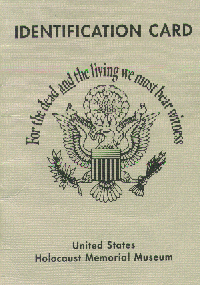 Years ago, a friend of mine returned from a visit to the
Years ago, a friend of mine returned from a visit to the "I entered the U.S. Holocaust Memorial Museum, I received Identification Card #2855. For the next four hours I became Malvin Katz Fried, a real Hungarian Jewish woman about my own age during the Holocaust.The industrial steel elevator I took to start my tour on the fourth floor immediately seemed as confining as the railroad boxcars that carried so many Jews to their deaths. Then as I threaded my way inexorably downward, through the history the displays recount, I lived Malvin's times and her personal story."
 Two years ago, a group of Second Life residents created “Neverland,” which recreated
Two years ago, a group of Second Life residents created “Neverland,” which recreated 
 After the visitor assumes their appearance, he or she can be directed on a journey through the camp to learn about the refugees’ history – why they came to the camp, their family, and even their personality. At the same time the visitor can learn about the issues camp-dwellers face over the course of a day: food, water, shelter, hygiene, etc. as well as information about what needs to be done to improve the situation.
After the visitor assumes their appearance, he or she can be directed on a journey through the camp to learn about the refugees’ history – why they came to the camp, their family, and even their personality. At the same time the visitor can learn about the issues camp-dwellers face over the course of a day: food, water, shelter, hygiene, etc. as well as information about what needs to be done to improve the situation.
The key to Neverland’s success was attracting the volunteer efforts of the best avatar creators, builders and coders in Second Life. I think this is the sort of idea that would excite them and it would be easy to recruit them to our cause.
I feel like if the idea succeeds like I think it can, it will be extremely popular inside Second Life. It also has the potential to create a much wider impact through publicity, attract more people to omidyar.net and spark more activism.
2 comments:
What a great idea - literally walking in someone else's shoes. I think it could be very powerful.
Neverland also used the "Williamsburg" approach where it had actors/avatars in character greeting visitors who could opt to pick a character or not, and then experience various aspects of the world as they explored it. So that you could control the degree of immersion. This might be a factor for a successful exhibit.
In the Holocaust Museum, the technique of giving the visitor the identity card helps them feel empathy -- as does the stark reality of the dark rooms with rough-hewn wooden bunks and low ceilings and many other realistic featurse of the Museum.
In the virtual setting, to reduce the complex suffering of Darfur to 10 stereotypes (like an already existing online game does), and have visitors don these very limited aspects of a person's life in Darfur, there is the risk that the suffering, stripped from inducing or enhancing empathy, becomes either abstracted or even triviliazed, as it can on television.
If a visitor is to be moved to action in the real world, the virtuality must act upon him not to trivialize or abstract, but to empathize with an outlet for action.
So it seems to me that having some space between the visitor and the exhibit so that the visitor can view, but still be moved to action, is important. Then onsite there could be things like cards to click to write Congressmen or donate to a specific project of an NGO helping people in Darfur or links to further reading.
I'm also thinking long-term, somehow virtual worlds have to be used not for simplistic rendering of one feature of a complex emergency, human suffering, but the aspects of the various actors in the story, those directly responsible, and their interests, i.e. oil, geopolitical concerns, etc. To try to see the interconnectivity of things.
Post a Comment